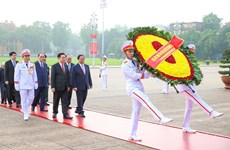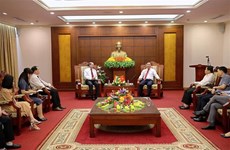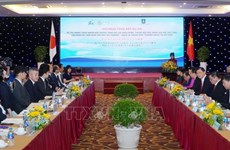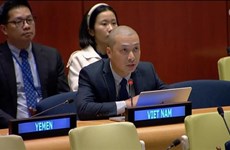Lao Cai urged to target sustainable growth
Prime Minister Nguyen Tan Dung has instructed Lao Cai province to exert
more efforts to promote all its potential for rapid and sustainable
development.
Prime Minister Nguyen Tan Dung has instructed Lao Cai province to exert
more efforts to promote all its potential for rapid and sustainable
development.
At a working session with the provincial authorities during his field trip to the northern mountainous province on April 21, PM Dung spoke highly of the province’s efforts over the past five years and in implementing the first year of the five-year plan 2011-2015. He stressed the implementation of Government Resolution 11, focusing on agricultural production, price control and expense saving.
He pointed out difficulties and shortcomings, mainly the high poverty rate of 42.99 percent, the trained labour rate of 27 percent and slow development of infrastructure that the province needed to overcome in the near future.
To help Lao Cai achieve sustainable development, the province should focus on combining development of agricultural land and assistance for farmers to banish poverty, he stressed.
PM Dung also instructed Lao Cai to continue to promote its potential on minerals, helping it become a national centre for the development of industry and processing minerals, such as apatite, copper and iron, along with hydro-power, as well as the development of tourism, particularly the Sa Pa tourist resort.
He asked the relevant ministries and agencies to ensure the implementation of the Hanoi-Lao Cai highway and infrastructure projects for transport, electricity and telecommunications.
The provincial leaders need to continue improving the quality of education and training, focusing on vocational training and building a strong political system, he said.
Despite a border mountainous province with many difficulties due to poor infrastructure and a lack of trained human resources, Lao Cai registered an annual economic growth rate of 13 percent over the past five years. It ranked second in the Provincial Competitiveness Index 2010 rankings released by the Vietnam Chamber of Commerce and Industry (VCCI).
In its socio-economic development plan, the province will promote agricultural development and the building of new-styled rural areas and focus on industry development in the next five years, striving for annual growth rate of 14 percent and per-capita income of 1,900 USD and poverty reduction of between 3-5 percent a year./.
At a working session with the provincial authorities during his field trip to the northern mountainous province on April 21, PM Dung spoke highly of the province’s efforts over the past five years and in implementing the first year of the five-year plan 2011-2015. He stressed the implementation of Government Resolution 11, focusing on agricultural production, price control and expense saving.
He pointed out difficulties and shortcomings, mainly the high poverty rate of 42.99 percent, the trained labour rate of 27 percent and slow development of infrastructure that the province needed to overcome in the near future.
To help Lao Cai achieve sustainable development, the province should focus on combining development of agricultural land and assistance for farmers to banish poverty, he stressed.
PM Dung also instructed Lao Cai to continue to promote its potential on minerals, helping it become a national centre for the development of industry and processing minerals, such as apatite, copper and iron, along with hydro-power, as well as the development of tourism, particularly the Sa Pa tourist resort.
He asked the relevant ministries and agencies to ensure the implementation of the Hanoi-Lao Cai highway and infrastructure projects for transport, electricity and telecommunications.
The provincial leaders need to continue improving the quality of education and training, focusing on vocational training and building a strong political system, he said.
Despite a border mountainous province with many difficulties due to poor infrastructure and a lack of trained human resources, Lao Cai registered an annual economic growth rate of 13 percent over the past five years. It ranked second in the Provincial Competitiveness Index 2010 rankings released by the Vietnam Chamber of Commerce and Industry (VCCI).
In its socio-economic development plan, the province will promote agricultural development and the building of new-styled rural areas and focus on industry development in the next five years, striving for annual growth rate of 14 percent and per-capita income of 1,900 USD and poverty reduction of between 3-5 percent a year./.













